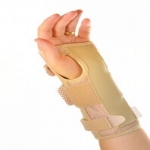
You have been diagnosed with Carpal Tunnel Syndrome. Now what do you do? There are several non-operative treatments that can be considered before pursuing a surgical option. Your surgeon will discuss what is specifically right for you.
Non-operative options
Symptoms may be relieved without the need for surgery. Activity modification, such as changing hand use patterns or splinting the wrist may help reduce the pressure on the median nerve. (for more information about the nerve and what is carpal tunnel, please see our first post) Wearing resting night splints may help relieve symptoms as well. In addition, a steroid injection may help reduce swelling surrounding the nerve. Exercises generally do not help symptoms because it may increase swelling around the nerve. Pills, nutritional supplements, and other treatments have not been shown in scientific studies to be beneficial either.
Operative Options
If symptoms persist or worsen, a carpal tunnel release may be necessary to make room for the nerve. Your surgeon may perform the surgery with a small incision or with an endoscope (meaning through a small camera)
The Carpal Tunnel Release Surgery will release pressure on the nerve to allow improved symptoms. It is important to note that your symptoms might not necessarily go away immediately. Dr. Clint Walker explains, “Surgery relieves pressure on the nerve, the nerve and your body must start the recovery process. This is like sitting on your leg and your leg falling asleep. Surgery is similar to standing up to relieve pressure on the nerve when your leg goes to sleep. Then the time it takes for your leg to wake up and the tingling to stop is your body and nerve recovering.”
He goes on to say that depending on how severe the nerve compression was before surgery, how long it has been occurring, and other medical conditions like smoking, diabetes, thyroid disease, and advanced age will affect the outcome. “Sometimes the nerve does not completely return to normal.
The goals of the surgery are two fold:
- To relieve pressure on the nerve and prevent the condition from worsening
- To allow your body and nerve to try to recover after the pressure is relieved.
References: American Society for Surgery of the Hand

